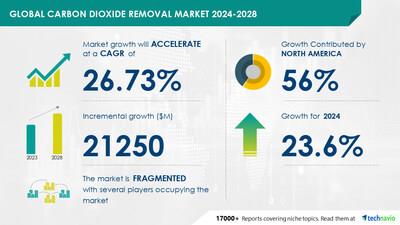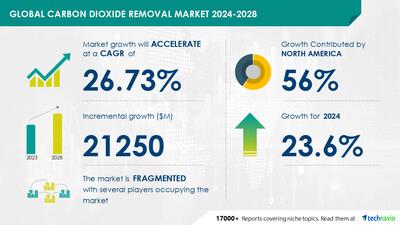
Carbon Dioxide Removal Market To Grow By USD 21.25 Billion From 2024-2028, High Investments Fueling Revenue. Report On AI's Role In Market Transformation - Technavio
| Forecast period |
2024-2028 |
| Base Year |
2023 |
| Historic Data |
- |
| Segment Covered |
Technology (DAC, CCS, Bioenergy with CCS, Soil carbon sequestration, and Others), Application (Industrial, Agricultural, and Energy production), and Geography (North America, Europe, APAC, South America, and Middle East and Africa) |
| Region Covered |
North America, Europe, APAC, South America, and Middle East and Africa |
| Key companies profiled |
Aker Carbon Capture |
Key Market Trends Fueling Growth
The Carbon Dioxide Removal (CDR) market is growing as businesses seek to reduce their carbon footprint. Companies are investing in CDR technologies such as carbon capture and storage, afforestation, and direct air capture. These solutions help businesses offset their CO2 emissions and contribute to a more sustainable future. The market is expected to reach significant growth due to increasing regulations and consumer demand for eco-friendly practices. Businesses can benefit from cost savings and improved brand reputation by implementing CDR strategies.
The Carbon Dioxide (CO2) removal market is experiencing significant growth as businesses and governments seek to reduce CO2 emissions and mitigate the impact of fuel combustion and industrial processes on the environment. Key trends include carbon capture technologies like CO2-EOR techniques in the oil and gas sector, and the use of CO2 in the chemical domain for enhanced oil recovery. Crude oil prices and climate policies influence the adoption of these technologies. CO2 removal methods include afforestation, reforestation, agricultural practices, ocean fertilization, and wetland restoration. Blue carbon approaches in the finance sector are gaining traction, with companies like Blueplanet, Carbon Engineering, CarbonCure, and CarbonFree leading the way. Energy costs and carbon emissions from shipping, pipelines, and geological formations are also targets for CO2 reduction. Technologies like microalgae, biochar, and carbon credits are essential tools for carbon offsetting and carbon dioxide removal.
Discover a Comprehensive 360° Market Analysis: Understand the Impact of AI. For detailed information- Request Sample!
Market
Challenges
-
The Carbon Dioxide Removal (CDR) market is growing as businesses seek sustainable solutions to reduce their carbon footprint. CDR technologies, such as carbon capture and storage (CCS) and direct air capture (DAC), are gaining traction. Companies like Carbon Clean Solutions and Climeworks are leading the charge, offering cost-effective and efficient CDR solutions. These technologies absorb CO2 from the atmosphere or industrial processes and store or utilize it, contributing to decarbonization efforts. The market is expected to reach significant growth in the coming years due to increasing demand from various industries, including energy, manufacturing, and transportation.
The Carbon Dioxide Removal (CDR) market is gaining momentum as businesses and governments seek to reduce CO2 emissions and mitigate climate change. However, challenges persist in implementing carbon capture technologies, particularly in coal-fired power plants and industrial processes due to high energy costs. CO2-EOR techniques offer potential solutions, but crude oil prices impact their viability. In the technology sector, companies like Carbon Engineering, CarbonCure, and CarbonFree are innovating with CDR tools such as microalgae, biochar, and carbon credits. Climate policies, afforestation, reforestation, agricultural practices, ocean fertilization, and wetland restoration are other CDR approaches. The finance sector, through initiatives like Blueplanet, is crucial for funding these efforts. Ocean alkalinization and carbon offsetting through shipping, pipelines, and geological formations are also being explored. Despite progress, challenges remain in scaling up these solutions and addressing the financial and regulatory complexities.
For more insights on driver and challenges
-
Download a Sample Report
Segment Overview
This carbon dioxide removal market report extensively covers market segmentation by
Technology-
1.1 DAC
1.2 CCS
1.3 Bioenergy with CCS
1.4 Soil carbon sequestration
1.5 Others
-
2.1 Industrial
2.2 Agricultural
2.3 Energy production
-
3.1 North America
3.2 Europe
3.3 APAC
3.4 South America
3.5 Middle East and Africa
1.1
DAC-
Direct Air Capture (DAC) is a notable carbon dioxide removal method gaining considerable attention. DAC technologies can be implemented at various scales, from small facilities to large industrial plants, making them adaptable for diverse locations. This flexibility enables seamless integration into existing infrastructures. DAC's ability to permanently store carbon dioxide underground or utilize it in various products through geological sequestration sets it apart from techniques with temporary carbon dioxide reduction effects. DAC's land efficiency is crucial in areas with limited land resources or land usage disputes. With expanding investments and regulatory support, DAC's scalability, permanence, and efficiency make it the dominant carbon dioxide removal method. As technology advances and costs decrease, DAC is poised to significantly contribute to global net-zero emissions goals and combat climate change, leading to market growth during the forecast period.
For more information on market segmentation with geographical analysis including forecast (2024-2028) and historic data ( - )
- Download a Sample Report
Research Analysis
The Carbon Dioxide Removal (CDR) market refers to technologies and practices that help remove or reduce carbon dioxide (CO2) from the atmosphere. Energy costs play a significant role in the implementation of CDR methods, with some techniques, such as Carbon Capture and Storage (CCS), requiring large amounts of energy. Blue carbon approaches, including afforestation, reforestation, and wetland restoration, naturally absorb CO2 from the atmosphere and offer cost-effective solutions. Other CDR methods include microalgae cultivation, biochar production, enhanced weathering, and ocean alkalinization. The CDR tool helps companies and individuals calculate their carbon footprint and offset CO2 emissions through various CDR projects. Carbon credit buyers can purchase these offsets to meet their carbon reduction targets. CO2 emissions result from fuel combustion and industrial processes, with ships and pipelines contributing significantly. Geological formations, CO2-EOR techniques, and chemical domain processes also release CO2. Climate policies and carbon pricing can incentivize the adoption of CDR methods. Other practices, such as agricultural practices and ocean fertilization, can also help reduce CO2 emissions.
Market Research Overview
The Carbon Dioxide Removal (CDR) market is a rapidly growing sector focused on reducing and removing CO2 emissions from the atmosphere. Energy costs play a significant role in CDR technologies, with some methods like Biochar and Carbon Capture requiring large amounts of energy for production. Blue carbon approaches, such as ocean alkalinization and wetland restoration, naturally absorb CO2 from the atmosphere and offer cost-effective solutions. Microalgae cultivation is another promising CDR technology, which converts CO2 into oxygen through photosynthesis. The CDR tool is essential for businesses and individuals to offset their CO2 emissions by investing in CDR projects. CO2 emissions from fuel combustion and industrial processes are major contributors to global greenhouse gas emissions, making CDR technologies increasingly important. CDR techniques like CO2-EOR (Enhanced Oil Recovery) and Ocean Fertilization are gaining popularity in the technology sector due to their potential to reduce CO2 emissions while also providing economic benefits. Crude oil prices and climate policies significantly impact the adoption of CDR technologies, particularly those related to the fossil fuel industry. The finance sector is also playing a crucial role in the growth of the CDR market through the provision of funding for CDR projects. Some notable CDR projects include those by Blueplanet, Carbon Engineering, CarbonCure, and CarbonFree. Afforestation, reforestation, and agricultural practices are other natural CDR methods that can help mitigate CO2 emissions.
Table of Contents:
1 Executive Summary
2 Market Landscape
3 Market Sizing
4 Historic Market Size
5 Five Forces Analysis
6 Market Segmentation
-
Technology
-
DAC
CCS
Bioenergy With CCS
Soil Carbon Sequestration
Others
-
Industrial
Agricultural
Energy Production
-
North America
Europe
APAC
South America
Middle East And Africa
7
Customer Landscape
8 Geographic Landscape
9 Drivers, Challenges, and Trends
10 Company Landscape
11 Company Analysis
12 Appendix
About Technavio
Technavio is a leading global technology research and advisory company. Their research and analysis focuses on emerging market trends and provides actionable insights to help businesses identify market opportunities and develop effective strategies to optimize their market positions.
With over 500 specialized analysts, Technavio's report library consists of more than 17,000 reports and counting, covering 800 technologies, spanning across 50 countries. Their client base consists of enterprises of all sizes, including more than 100 Fortune 500 companies. This growing client base relies on Technavio's comprehensive coverage, extensive research, and actionable market insights to identify opportunities in existing and potential markets and assess their competitive positions within changing market scenarios.
Contacts
Technavio Research
Jesse Maida
Media & Marketing Executive
US: +1 844 364 1100
UK: +44 203 893 3200
Email:
[email protected]
Website:
SOURCE Technavio

Legal Disclaimer:
MENAFN provides the
information “as is” without warranty of any kind. We do not accept
any responsibility or liability for the accuracy, content, images,
videos, licenses, completeness, legality, or reliability of the information
contained in this article. If you have any complaints or copyright
issues related to this article, kindly contact the provider above.



















Comments
No comment